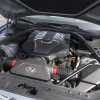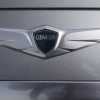To say Hyundai grabbed everyone’s attention when they launched the Genesis at the 2008 North American International Auto Show is a true understatement. Here was a model that came with rear-wheel drive, a choice of either a V6 or V8 engine, many luxury appointments and features, and the value the company was known for. The Genesis left many wondering what the devil the company was doing, but Hyundai had a plan. The Genesis was a model they thought would not only bring new people into the Hyundai fold; it would raise the allure of the brand. That’s just what the model did. Consider this: In 2009 when Genesis was on sale for a full year, Hyundai sold 13,604 Genesis models. In 2013, that number rose to 19,804, an increase of 46 percent.
Now enter the 2015 Genesis. The second-generation models builds on what the first has done with improvements to theinterior, powertrain, chassis, and refinement. But Hyundai also has bigger ambitions as well with this model. During the presentation at the Detroit Media Preview, Hyundai named the likes of the BMW 5-Series, Cadillac CTS, and Mercedes-Benz E-Class as competitors to the Genesis. Big names to say in the least. Does the Genesis have what it takes? Read on.
The 2015 Genesis is the first model in Hyundai’s lineup to introduce their latest design language named Fluidic Sculpture 2.0 which basically boils down to the design being a bit more restrained and losing a bit of the curvy-ness that the company was known for. Despite the loss in curves, the 2015 Genesis still seems to stand out. Cues such as the large, hexagonal grille up front; a choice of eighteen or nineteen-inch wheels, LED lighting along the outer edges of the headlights, and chrome exhaust tips give the 2015 model an identity. The same cannot be said for the first-generation Genesis. Overall length has increased to 196.5 inches, which allowed Hyundai’s designers to give the model a bit more aggressiveness by sharply raking the roofline at the rear to give a somewhat of a fastback shape. After seeing the Genesis in person, I can say for the most part that I like the design. My only problem is the front with the large grille. It makes the Genesis look too comical.
Moving inside, the 2015 Genesis’ interior has been fully changed. The dash is logically laid out and controls are within easy reach of the driver and passenger. Materials are top notch with leather on the seats, an abundance of soft-touch materials on the dash and door panels, and real aluminum and wood trim. Seats offer a nice balance of comfort and support, along with twelve-way power adjustments. The seats were so comfortable in fact, my drive partner was falling asleep during the drive. Back seat passengers will be impressed by the amount of head and legroom on offer. Hyundai says the Genesis has more cubic feet of interior room than just about anything in the class.
On the technology front, all Genesis models come with eight-inch touchscreen with navigation, a 4.3-inch color screen in the instrument cluster providing trip computer info, BlueLink telematics, and what the company calls Smart Trunk. Smart Trunk is where you stand near the back of the vehicle with the proximity key on you and within three seconds, the trunk will automatically open. Now before you think that the trunk will open up whenever you are near the vehicle, Hyundai says you have to have the vehicle locked and away from it for fifteen seconds before you can use this feature. Options include a 9.2 HD touchscreen, head-up display, and a 17-speaker Lexicon audio system.Powertrains carry over from the last-generation model, but have received a number of tweaks to improve drivability. The 3.8 V6 now makes 311 horsepower and 293 pound-feet of torque, while the 5.0L V8 makes 420 horsepower and 383 pound-feet of torque. An updated eight-speed automatic is the sole transmission for both engines. New for this generation is HTRAC all-wheel drive. The system which was developed in-house by Hyundai utilizes an electronic variable-torque-split clutch with active torque control between both the front and rear axles. The system normally operates at a 40/60 split, but can send up to 90 percent of power to either the front or rear axle. The system is available on the V6 only.
Alright, enough about the details on the 2015 Genesis. Lets take a drive.
Even though the 2015 Genesis weighs more than the outgoing model (4,138 lbs for the V6, 4,295 lbs for the V6 HTRAC, and 4,541 lbs for the V8), both engines are up to task of moving the vehicle at a brisk rate. The V8 produces a nice growl when you step on it and power comes very effortlessly. However the V6 engine is the sweet spot as feels just as powerful as the eight and gets better fuel economy overall. During the drive loops, I recorded an average 22 MPG in the V8, while the V6 with HTRAC AWD system got 25 MPG. The eight-speed showed the same characteristics as in theEquus I drove last year; smooth and quick shifts up and down the eight speeds. As for the all-wheel drive system, I couldn’t say if it improved handling or not. I’ll need to spend some more time with a Genesis to find out.
Under the skin is a stronger structure with high-strength steel used throughout, revised multilink suspension front and rear, new variable-ratio, electric power-assist steering, and an optional continuous damping control system on the V8. What this means is that the Genesis is one of the first Hyundai models that actually drives pretty well. Both models showed no body roll and stability when pushed into corners, while steering provided good feel and weight. Now I can’t say whether it's as good to drive as a BMW 5-Series or Cadillac CTS till I drive either one. What I can say is compared to past Hyundais, the Genesis shows signs of improvement. Now all of those changes I talked about which improving the driving dynamics also help in thecomfort and quiet department. The Genesis’ suspension setup was able to soak up potholes and imperfections like they were nothing. Wind and road noise were kept to a minimum.
Now onto the price tag. Hyundai has bumped the price of the 2015 Genesis by $2,500. So the base Genesis with the 3.8 V6 will now cost $38,000 (not including a $950 destination charge). That price increase nets you more standard features such as navigation, backup camera, Hyundai’s BlueLink Telematics, power folding mirrors, rain sensing wipers, and much more.
With the first-generation Genesis, Hyundai made a statement of intent. The brand who was known for the Pony and the 10 Year/100,000 Mile warranty wanted to show that it could reach higher and become something to aspire to. With the second-generation Genesis, Hyundai begins to solidify that.
Disclaimer: Hyundai provided the vehicles and a lunch during this first drive event.
Year: 2015
Make: Hyundai
Model: Genesis
Engines: 3.8L V6 (311 Horsepower, 293 Pound-Feet of Torque), 5.0L V8 (420 Horsepower, 383 Pound-Feet of Torque)
Driveline: Rear-Wheel Drive, All-Wheel Drive
Fuel Economy: City/Highway/Combined - 18/29/22 (3.8L V6 RWD), 16/25/19 (3.8L V6 AWD), 15/23/18 (5.0L V8 RWD)
Curb Weight: 4,138 lbs (3.8L V6 RWD), 4,295 (3.8L V6 AWD), 4,541 lbs (5.0L V8 RWD)
Location of Manufacture: Ulsan, South Korea
Base Price: $38,950 (3.8L V6 RWD), $41,450 (3.8L V6 AWD), $52,450 (5.0L V8 RWD) (Includes a $950 destination charge)
William Maley is a staff writer for Cheers & Gears. He can be reached at [email protected]or you can follow him on twitter at @realmudmonster.








-3707742431.jpg.06edf8e14f4ccf35c60d4774a543cc11.jpg)



Recommended Comments
Join the conversation
You can post now and register later. If you have an account, sign in now to post with your account.
Note: Your post will require moderator approval before it will be visible.